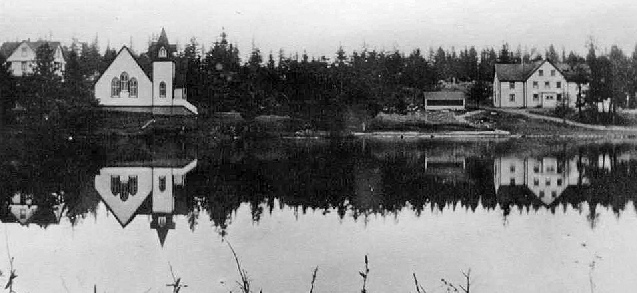Evangel Island Journey 10 -
The Evangel at Long Island and Woody Island (Camp Woody Begins)
By Timothy Smith (revised in 2020)
The EVANGEL Goes to Camp! Part One (The Beginning)
The first decade of Christian camping in Kodiak: Written for the 50th Anniversary in 2006
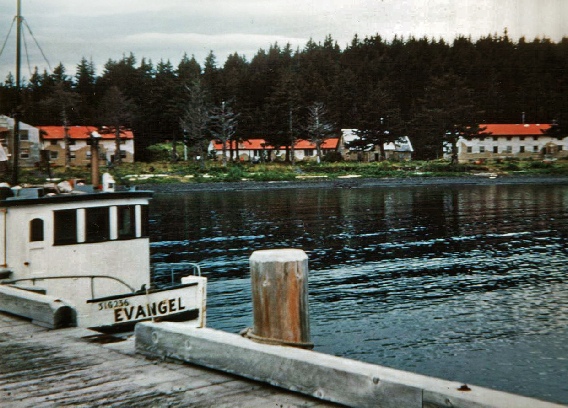
This rare photograph shoes the Evangel tied up at the Army dock in Cooke Bay, Long Island, in 1953, the first year of camping there. (From the Camp Woody collection)
The World War II barracks of the administration center of Fort Tidball, long since
abandoned, served as a good site for camping. The buildings still had windows, and
still sported their wartime camouflage (although the Army had re-
Author’s Note: The Evangel is remembered by a generation of Kodiak Island residents as the way to get to camp. The boat was the main transportation to and from camp on Long Island in the early 1950’s, and the ferry to Camp Woody when the camping program moved permanently to Woody Island in 1956.
The Evangel was an integral (and many say unforgettable) part of the camping experience. It would be impossible to tell the story of the early days of Christian camping in the Kodiak area without including the little boat that got everyone there, or my parents, Rev. Norman and Joyce Smith, who helped to develop and expand Christian camping in Kodiak. So this part of the journey spends a little time ashore as well.
The time period of this brief history covers the early locations used for camping, the Baptist Mission’s reacquisition of the property on Woody Island, and the early years of Camp Woody. The companion article will take the reader along for a week at Camp Woody in the 1960’s. Later chapters will feature the 1970’s, when people of my generation began to take on leadership at the camp.
In the frantic early years of World War II, Alaska did not fare very well. America was thrust into war by a surprise attack on Pearl Harbor in Hawaii, but Alaska had the distinction of being the only US soil actually invaded and occupied by an enemy during that conflict. The Japanese took and occupied the islands of Kiska and Attu in the Aleutian Chain, and bombed the base at Dutch Harbor. The military began a huge project of building fortifications, bases and outposts along the Alaskan coast, including many in the Kodiak area. A very large Army base was built on Women’s Bay near Kodiak, with Navy facilities as well. Coastal batteries and gun emplacements were installed at Fort Smith at Chiniak, and Fort Abercrombie at Miller Point, and roads were cut connecting these facilities with the town of Kodiak and the main base. Long Island, a narrow, twisting strip of land with a large natural harbor, several large lakes, and a series of seaward cliffs, became Fort Tidball, an extension of the larger Fort Greely in Kodiak. The war eventually moved on, leaving a picturesque island littered with barracks, Quonset huts, bunkers, gun emplacements, radar towers and searchlight depots. The main base on Women’s Bay became the Kodiak Naval Air Station and Coast Guard Base.
Camping at Fort Abercrombie, near Kodiak, 1951-
The program which eventually became Camp Woody actually began when several churches,
including the Community Baptist and the Protestant Chapel at the Navy Base, collaborated
to begin a youth camping program. My parents, Norman and Joyce Smith, along with
Estelle Marlin and Bill and Zelma Stone from the Kodiak Baptist Mission, and Rev.
and Mrs. John and Dorothy Molletti of the Community Baptist Church were part of the
founding group of Christian workers who established the first camp at Fort Abercrombie
in the summer of 1952. That extensive facility was well-
A Photo Gallery of Camping at Fort Abercrombie, 1951-




Top photo: Campers and staff at Fort Abercrombie in 1952. Middle photos: two existing Army Quonset huts used by the camp, the mess hall and the girls’ hut. Bottom photo: Rev. Norman Smith, standing, leads singing around the campfire at Fort Abercrombie, 1952. (Camp Woody Collection photos)
The Long Island (Fort Tidball) Camping Experience, 1953 to 1955
The easy access of Fort Abercrombie by road from Kodiak was its undoing as a campsite, and the following year, the churches decided to look for another suitable site. Long Island, several islands out from Kodiak, had similar facilities, but was remote enough to provide the privacy needed to run a camping program. The Long Island camp on the site of the abandoned Fort Tidball began its first season in the summer of 1953. The camp was established in the old Army administrative center barracks at the south end of Cook Bay. At that time, most of the buildings still had windows and even working electrical systems, as the photos attest. Two of the barracks were converted into boys and girls’ dorms, and the long original mess hall in the center was also used as the chapel. All the cooking equipment, food, beds, mattresses and such were donated by the Navy or local churches, and brought to Long Island every season on the Evangel, sometimes assisted by other boats.
That first summer of 1953 was also my first summer. I went to camp as an infant, in the care of my mother, who was working as a girls’ counselor. A letter in Yule Chaffin’s files reports how one of the other counselors, on staff at the Mission, took great exception to my presence. I had a couple of fussy nights, as infants sleeping in abandoned buildings are wont to do. The letter read in part, “I can’t understand why Joyce doesn’t just take her baby out to the Evangel and sleep out there. None of us got any sleep last night due to the baby’s constant crying!” So apparently in the early days of camping, I wasn’t really much good.
The Long Island camp was, by all accounts, very successful and popular. The buildings were funky and deteriorating, but the island was gorgeous, and the camping program was run by people who loved kids and loved camping. On several occasions, at Long Island and later at Camp Woody, kids from the outlying villages were brought to camp on the Evangel, giving them the opportunity to experience a dynamic Christian environment and meet other believers from town. Several other island missionaries, including the couple at Afognak, participated in the camp and brought in kids from their villages. Many of the campers remember the little pump organ that we would bring ashore from the Evangel, and of Norman and Joyce Smith leading the singing in the mess hall chapel services. It was a wonderful beginning, and the start of many camping traditions. But Long Island as well soon became an unsuitable spot to run a camping program. The buildings close to the beach (which is where the camp was held) were increasingly the victims of vandalism and scavenging, and every succeeding year involved bringing more materials to repair the buildings enough to use. 1955 was the last season of the camp on Long Island. (Continued below…)
A Photo Gallery of Camping on Long Island (1953 to 1955)



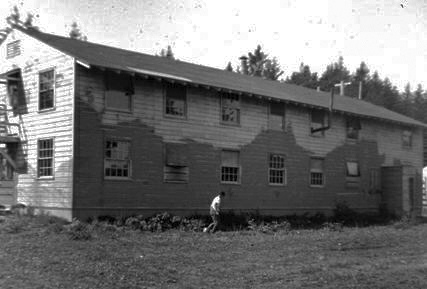


Bow view, stern view: Two of Dad’s slides from 1955 show campers loading up to go to camp. This scene would be repeated every summer for many years.
The camp site on Long Island in 1953 (left) with windows intact, and in 1955 (below) with evidence of deterioration and vandalism. It became difficult to bring in all the windows, the stove, heaters, and other supplies every year. (Camp Woody Collection)
The camp site on Long Island at worship and Bible study
Top: an outdoor worship service on the old parade grounds. Below that: Mom leads a Bible study out on the dock. Next: a group of campers do a Bible study out on the beach. Bottom: the mess hall doubles as a chapel in this worship service with some energetic singing going on! Although the ceiling panels are falling off, the camp staff has managed to hook the Evangel’s generator into the old wiring and the lights are on! (Camp Woody Collection).



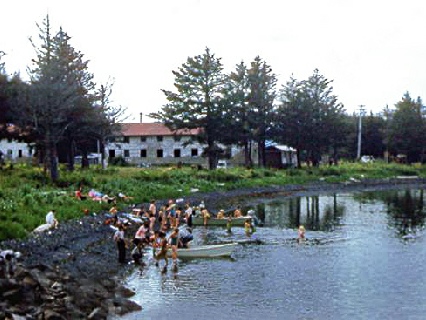

Long Island, Alaska is a great place to hike and explore, but no photos of those campers hiking have survived. See the Long Island articles for what my friends and I did in the 1970’s! But they obviously had fun in these photos!
Top Left: brave Alaskans all – campers go swimming in the cold waters of Cooke Bay, and I don’t even see a campfire! Top Right: My Mom (face to camera) and her cabin group are performing some kind of bedroom scene on skit night in the mess hall. (Camp Woody Collection) Bottom: Until the Tidal Wave swept them all away, a huge stack of empty and rusting oil barrels made for hours of entertainment. In the photo, campers come up with silly contests like this race about to begin. Meanwhile, the guy in the foreground practices his moves! This photo was taken in 1962, when Camp Woody visited Long Island, but the original campers used them, too. By 1964, all the buildings had no windows or doors, and so they survived the Tsunami without a scratch! But the barrels all vanished. (Mab Boko photo)


Top: The last camp on Long Island poses in front of the old fox farm home in the summer of 1955. (The military in WW II had built their fort around the abandoned ranch, and camouflaged their buildings with nets) Right: campers wave goodbye to the Evangel as it pulls away from the Long Island dock in this probably staged photo. But 1955 was to be the last season on that island.
A New Home: Camp Woody’s Early Years, 1956 to 1964
As we have seen, the Christian camping program in Kodiak had already made great use
of two abandoned military facilities. But they were running out of options, and needed
a permanent site as soon as possible for the 1956 season. A door closed in the spring
of 1956, when the US government undertook a program called the “Aleutian Cleanup,”
designed to render remaining weapons at remote sites harmless, destroy sensitive
equipment, and return commandeered land to its rightful owners. Long Island abruptly
became off-
However, a much better door was about to open. A wonderful camping site was about
to be dropped into our laps. The Kodiak Baptist Mission orphanage had been originally
established in 1893 on almost 600 acres of land on Woody Island. Although all the
staff and children had moved across the channel to new facilities in 1938, the Baptists
had re-
Early in 1941, the Navy had commandeered the Woody Island property, and constructed a submarine net depot. Across Mirror Lake, on the site of some of the original Mission buildings, the Navy built a large barracks, warehouse, dormitory for bachelor officers, and a mess hall. They also installed a water and sewer system in the buildings, and built a pump house and large water tower. The main buildings had been converted into apartments for the CAA (which later became the FAA), but recently they had built a much larger facility on the other side of the island. So all of the facilities constructed on Baptist land were now vacant, still functioning, and now in the hands of the very people who needed a new site for a Christian camp! (Continued below the photo gallery)
A Brief Photo Gallery of Some of Woody Island’s History




Top: The Baptist Mission complex on Woody Island in 1925. Note the little church that was the first Protestant sanctuary in Alaska, built in 1894. On the right is the dormitory that burned, was rebuilt, and burned again. On the far left is a second dormitory, which was dismantled after all children’s housing was moved to Kodiak in 1938. (Photo is from the Chaffin collection)
Note: Woody Island has a rich Native heritage as home to one of the Kodiak area’s
oldest communities. But almost everyone had moved away by the mid-
Left: The gravestone of a girl from the children’s home who died in a smallpox epidemic in the early twentieth century was still visible in the woods above camp in the 1960’s. Middle: the sole surviving Mission building as it looked in 1970. Right: a recent photo of the old Mission foundation, with radiators still visible behind the alder bushes.
Three photos of historic buildings still visible in 1956, but torn down by 1958.
Top: The old schoolhouse (red roof) and three Navy buildings can be seen across Mirror
Lake. The tan-

The FAA Station on Woody Island built its main facility on the opposite side of the
island after it vacated the Camp Woody site in the early 1950’s. By the early 1970’s,
the 300-
Top Photo: An aerial view of the FAA station from above the Woody-
Hammering Together a Permanent New Site on Woody Island
Making a fully-
Finally, and on time, Camp Woody opened its doors for its inaugural season, in the summer of 1956. Each of the cabins featured various hanging pipes and wires, and the remains of old Venetian blinds graced the windows. The dining hall was a wonder, made from multiple rooms of the CAA apartments. Every few feet the walls were a different color. The floor was a patchwork of painted wood and linoleum tiles. And there had been no time to remove the two apartments’ restrooms from the center of the new mess hall. So the first season, the dining hall was in the shape of a U, with two restrooms right in the middle. To this day, the plumbing for the upstairs restrooms drops right through the middle of the dining hall. The volunteers did get the water supply from Tanignak Lake to work, thanks to a pump that managed to get just enough water from the pump house into the aging water tower on the other side of the camp grounds. And the ancient wooden sewer lines worked as well. But even with all its flaws, the new “Camp Woody” on Woody Island was a huge step up from the austere conditions on Long Island, and youth camping in Kodiak now had a permanent new home!
Camp Woody was an immediate hit. Right in front of the main camp building was pretty
Mirror Lake, and a short jog around it to the other side, there was a fine swimming
hole. The Evangel’s two rowboats became part of the camp equipment for the summer
(as did the generator we used in Larsen Bay in the winter). Beside the camp, a little
higher than Mirror Lake, lay beautiful Tanignak Lake, the source of the Navy’s drinking
water (and the source of this website’s name). The camp soon made a little outdoor
chapel on a point of land that jutted out into the lake, giving it the perfectly
truthful if not imaginative name of “Inspiration Point.” The Baptist Mission, landlords
of the camp, soon procured a small herd of cattle and a free-
We had good reasons to thank the practical wartime US military for so many things
that made Camp Woody a superior site. Among these was a sparse but very useful gravel
road system, which basically divided the island into thirds. The main road from
the dock wound its way through the trees and over hills and valleys to the new FAA
station on the far side of the island. Along the way, the “Sawmill road” branched
off, passing under the huge 300-
Back at the end of the main road, high above the Long Island channel, the FAA ran
a village-
A Photo Gallery of the Early Days of Camp Woody


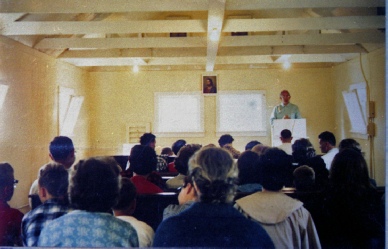



Left top: Mirror Lake swimming hole with the main camp building in the background. Left bottom: A group of campers at the same swimming hole.
Woody Island’s once famous ice industry: In the color slide, the old pilings visible in the lake are the remains of the old ice cutting facility’s rail system, which ferried blocks of clear ice from Tanignak Lake (behind the trees) across Mirror Lake on ore carts to waiting sailing ships through the 1860’s. (Think the opening lake sequence of Frozen). In the years before refrigeration, ice from Tanignak made it as far south as San Francisco, packed in sawdust from Woody Island’s spruce trees! In fact, refrigeration eventually cut into Alaska’s ice business, and at the time of the Alaska purchase in 1867, the price included reimbursement for unsold ice blocks stored on Woody Island! All of this took place on land that is part of, or beside, what is now the Camp Woody property. The pilings are long gone now, mowed down by the Tidal Wave of 1964, which rose right up to the foundations of the camp buildings, and changed lovely Mirror Lake into a brackish lagoon. The camp swimming hole is now at Ehuzhik Lake, near the center of the island.
Camp Woody at worship: In the top right photo, Rev. Norman Smith (my Dad) leads a
vesper service at Chabitnoy Beach, near camp in the ‘60’s. These wonderful, meaningful
services are a persistent favorite memory of those who attended the early years of
Camp Woody. Bottom right photo: a chapel service in the mid-
The camp chapel, shown in a previous photo being moved across the island, sits where
the 1894 Baptist church once stood. The original yellow walls were finished with
white paint mixed with mustard when the original yellow paint ran out! It is a small
building, but the acoustics are amazing, making for many memorable song services.
It is now the camp’s wood shop, with services moving to the old boys’ dorm and then
on to the brand-
Above: Two photos from the last night of a senior high camp in 1959. The main camp
building’s mess hall has been painted a cheery cream over turquoise, and modern cooking
equipment is beginning to show up in the kitchen. As a normally low-
In the first few years, Camp Woody changed a lot. The dining hall finally was open space once the two apartment restrooms were removed. The camp acquired two whole buildings from the FAA, which were towed across the island with a Caterpillar tractor and became the chapel and the craft house. A shiny new metal roof on the main camp building replaced the leaky tarpaper one the Navy had left. But it would be almost twenty years before the old Cellotex cardboard walls of the dining room gave way to smooth sheet rock (Larry Le Doux and I lost a hammer somewhere in the walls…that’s another story). At least it was all painted (cream over turquoise), but the floors remained a checkerboard from the many rooms of the previous apartments for many years. All of this just added to the charm of the place. The people, the atmosphere, and the beauty of the island itself is Camp Woody’s luxury, not the austere accommodations!
So what were the early days at Camp Woody like? First of all, there is no overstating
the beauty of Woody Island. It seems all the best meadows, the longest sandy beaches,
the most stunning old growth spruce forests, and picturesque lakes in the Kodiak
area took a vacation on Woody Island and decided to stay. Secondly, surrounded by
such beauty, it is easy to turn your attention to God and His creation. To be honest,
many of the Christian workers in the old days seemed too frequently to be caught
up in an uptight, Puritanical mindset that was repellent to many people, including
me. But on Woody Island, everyone seemed to be on their best behavior. That included
me, too. It was a spectacular place to be a kid, and to grow into manhood. I’m
blessed to have spent the first twenty-
Another feature of Camp Woody, one which it still boasts today, was its ability to
draw good people to it like a magnet. Many of the townspeople became avid camp supporters,
“without which none of this could have happened…” as someone’s thank-
The Smith Family Legacy: Camp Woody and the EVANGEL

Top photo: The Evangel approaches the Woody Island dock with campers in this Mab
Boko photo from the mid-
Rev. Norman Smith served as resident pastor, maintenance man, and transportation coordinator for Camp Woody for over 20 years, meaning that he and Mom did just about everything at one point or another!
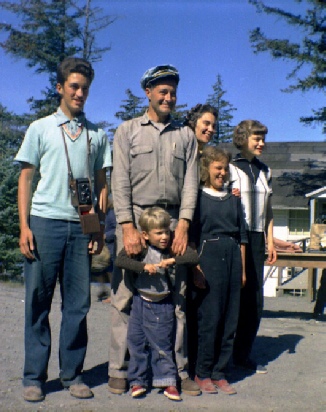


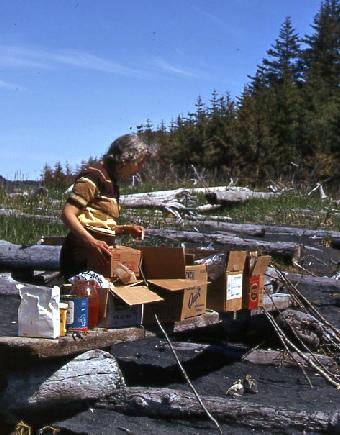

Top left: Mom (Joyce Smith) helps the camp cooks get a hot dog roast ready at Sawmill Beach. Notice the alder branches all ready to use as hot dog sticks. (Mab Boko photo) Top right: Mom leads a Bible study in 1957. Right: Mom plays the pump organ from the Evangel for two unidentified singers in the Camp Woody barn in 1956.
Mom Joyce Smith served as camp manager every summer for over twenty years, which meant doing everything from training the volunteer staff to helping the cooks, leading Bible studies, accompanying the singing, and being the camp nurse!

Top left: A 1957 portrait of the Smith family, the Evangel crew: Noel (with camera),
Rev. Norman Smith, Joyce Smith, Jerilynn Smith. In the front is a squirrely-
My parents, as Baptist missionaries to Kodiak Island since the early 1950’s, were fixtures of Camp Woody for the first two decades, as they had been at Abercrombie and Long Island. Rev. Norman Smith, my Dad, served by providing transportation using the Evangel or a skiff, by keeping the pump and generator running, and generally holding the place together. But he also was resident pastor for the camp and staff, and stepped in as pastor for the various groups whenever the need arose. Mom Joyce provided the training and orientation for all the counselors, played the organ at all the chapel services, and stepped in to help the cooks or counselors as needed. She also served as camp nurse. They were the camp directors for many years, and outlasted most of the original founders, serving every summer until Dad retired in 1977 and went to work for the city of Ouzinkie.
In 1996, Norman Smith went home to be with the Lord, and in 2005, the camp dedicated a park bench beside Mirror Lagoon in his honor. Mom Joyce was on hand to be the keynote speaker. The service united enthusiastic campers of many generations, together for a joyful time of praise, worship and remembrance. In 2006, Mom was the keynote speaker at the fiftieth anniversary of Camp Woody. It was to be her last public appearance, for she passed away at her home in Ouzinkie a little over a month later. In 2012, the new camp chapel was named partially in their honor. The ongoing ministry of Camp Woody is the legacy of these and many other pioneers. Continued below…)

Rev. Norman Smith poses for the camera in the summer of 1956, bringing a bunch of campers back to Kodiak. I like the bow tie! Inset: The Evangel prepares to dock in the Near Island channel, returning from Woody Island with a load of campers in the summer of 1957 in this very faded photo taken by Bob Railsback, who at the time was second in command at the Kodiak Naval Air Station. His daughter was aboard the Evangel. I ran into Bob and saw his slides after telling his (now grown) daughter, who was my dental hygienist in California, where I was from. The legacy of Camp Woody and my parents’ ministry is very wide indeed!


Left: The author, Timmy Smith, poses with a pile of bricks from the collapsed Navy mess hall in the summer of 1959. Right: Tim Smith (standing) leads an evening service as pastor of the Junior High camp at Camp Woody in the summer of 1998. The location is “High Inspiration Point” on the bluff overlooking Tanignak Lake on Woody Island.
The End of the Beginning
So far, I have given a brief overview of Camp Woody’s rich history, and of course, that story needs to be told. But this version leaves far too much out, and covers only the first few years, from my own perspective and knowledge. The task of a thorough history of Camp Woody should go to someone else. On all the other voyages with the Evangel, I have told my own story, as it happened. So the next installment is a personal narrative of life as it was at Camp Woody in the 1960’s. Up next is “The Evangel Goes to Camp: A Week at Camp Woody in the 1960’s,” including my experiences there from roughly 1961 to 1970.


Above: A composite photo of the mess hall that collapsed, from photos of the Navy’s
WWII submarine net station. To the far left is the B. O. Q. (Bachelor Officers’ Quarters)
that became the boys’ dorm and later rec hall / chapel for the camp. To the far right
is the edge of the two-
The next article is “The Evangel Goes to Camp:
A Week at Camp Woody in the 1960’s”
To get to the Camp or Evangel indexes, please click on the logos below:
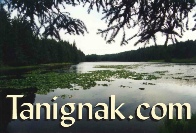
To Find Out More About Tanignak.com, Click HERE
To Visit My “About Me” Page, Click HERE

To Get Back “Home”
Please Click on the Site Logo Below:
Information from this site can be used for non-
